engine MAZDA PROTEGE 1992 Workshop Manual
[x] Cancel search | Manufacturer: MAZDA, Model Year: 1992, Model line: PROTEGE, Model: MAZDA PROTEGE 1992Pages: 1164, PDF Size: 81.9 MB
Page 965 of 1164
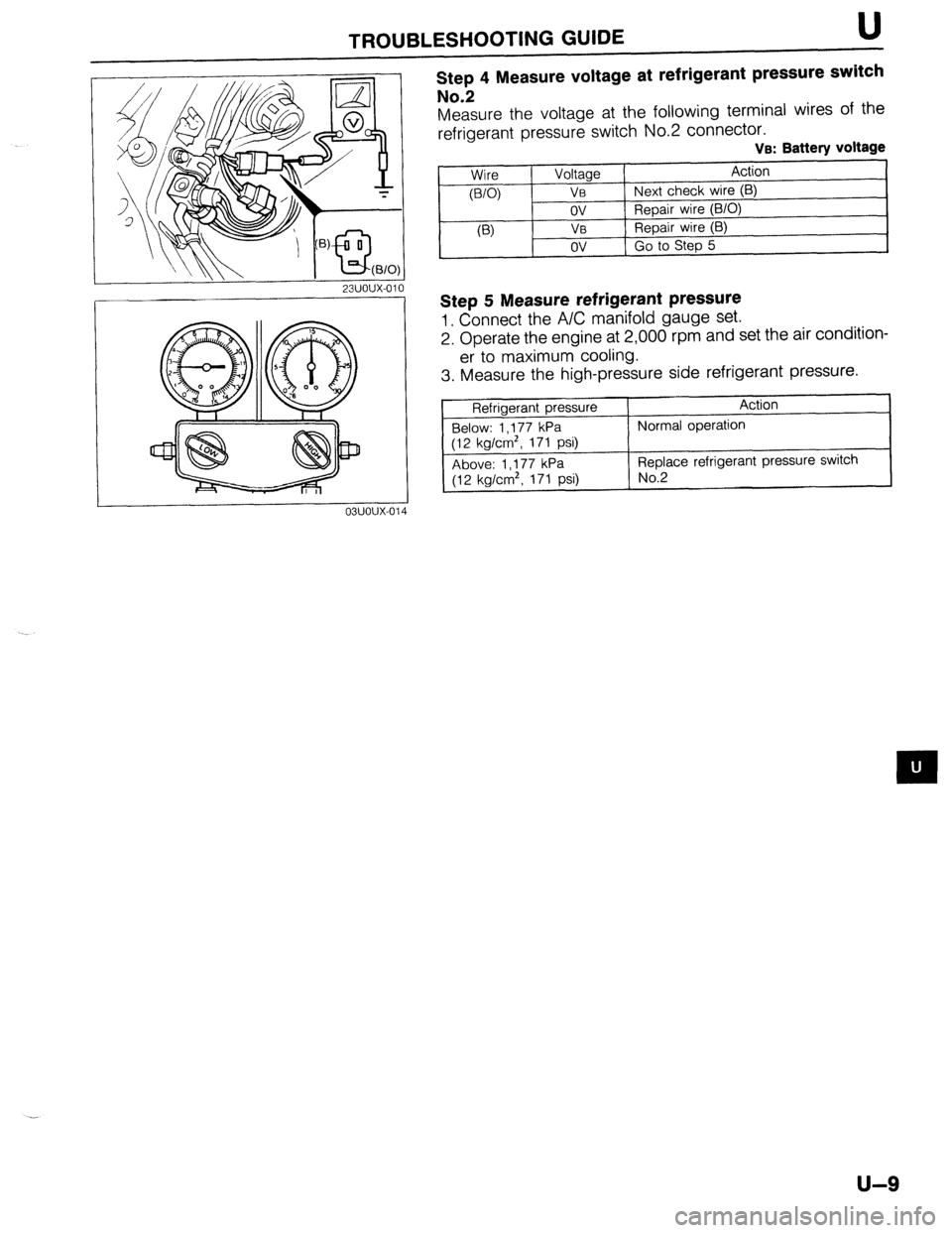
TROUBLESHOOTING GUIDE U
‘)
IO
1
Step 4 Measure voltage at refrigerant pressure switch
No.2
Measure the voltage at the following terminal wires of the
refrigerant pressure switch No.2 connector. VB: Battery voltage
Wire
WO)
(‘3 Voltage Action
VB Next check wire (B)
ov Repair wire (B/O)
V0 Repair wire (B)
ov Go to Step 5
Step 5 Measure refrigerant pressure
1. Connect the A/C manifold gauge set.
2. Operate the engine at 2,000 rpm and set the air condition-
er to maximum cooling.
3. Measure the high-pressure side refrigerant pressure.
Refrigerant pressure
Below: 1 ,177 kPa
(12 kg/cm*, 171 psi)
Above: 1 ,177 kPa
(12 kg/cm’. 171 psi) Action
Normal operation
Replace refrigerant pressure switch No.2
u-9
Page 966 of 1164

U TROUBLESHOOTING GUIDE
Symptom: Magnetic clutch does not operate. (Condenser fan operates normally.)
03uoux-015
_-I
I 23UOUX-011
Step 1 Measure voltage at compressor connector
1. Run the engine at idle.
2. Turn A/C and the blower switches ON.
3. Measure the voltage at the following terminal wire of the
compressor connector.
VB: Battery voltage
Wire
P/W Voltage
V0
ov Action
Go to Step 2
Go to Step 5
Step 2 Measure voltage at magnetic clutch connector
Measure the voltage at the following terminal wire of the mag-
netic clutch connector. Ve: Battery voltage
--
Wire Voltage Action
(B)
VB Go to Step 3
ov
t Go to Step 4
Step 3 Check magnetic clutch
1, Disconnect the magnetic clutch connector.
2. Check for continuity between the magnetic clutch and a
body ground.
Continuity
Yes
No Action
Adjust magnetic clutch clearance or
check for compressor internal trouble
Check ground wire
If ground wire OK, replace magnetic
clutch
Step 4 Check thermal protector
1. Turn the air conditioner OFF for about 10 minutes.
2. After 10 minutes, check for continuity of the thermal pro-
tector.
Continuity Action
Yes Normal operation
No Replace thermal protector .._
Page 968 of 1164
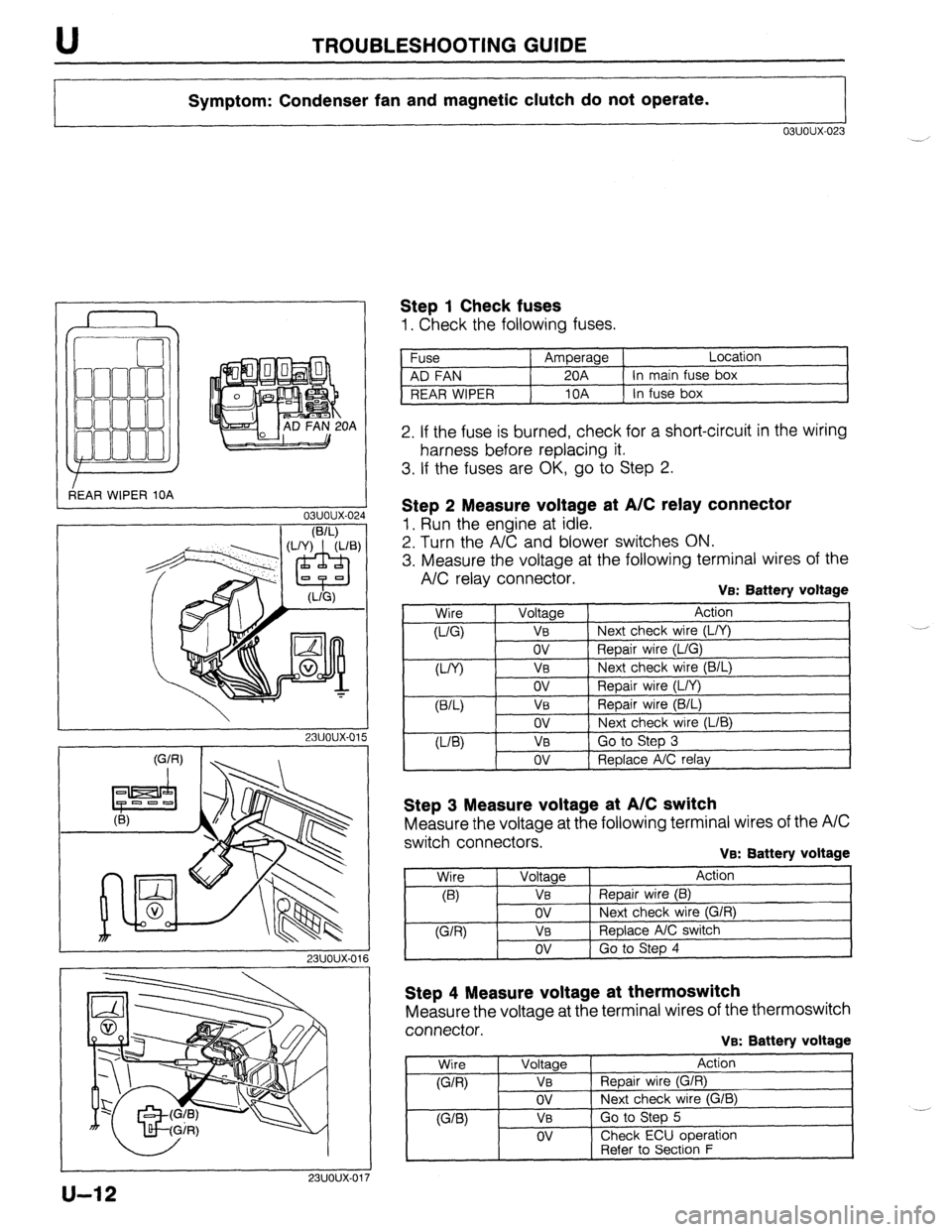
TROUBLESHOOTING GUIDE
Symptom: Condenser fan and magnetic clutch do not operate.
03uoux-023
r
3EAR WIPER 10A OA
L
03uoux-02.
I
1 Step 1 Check fuses
1. Check the following fuses.
Fuse Amperage Location
AD FAN 20A In main fuse box
REAR WIPER 10A In fuse box
2. If the fuse is burned, check for a short-circuit in the wiring
harness before replacing it.
3. If the fuses are OK, go to Step 2.
I
23uoux-011
Step 2 Measure voltage at A/C relay connector
1. Run the engine at idle.
2. Turn the A/C and blower switches ON.
3. Measure the voltage at the following terminal wires of the
A/C relay connector. VEX Battery voltage
,
Wire
0-Q
W) Voltage Action
VB Next check wire (L/Y)
ov Repair wire (L/G)
V0 Next check wire (B/L)
ov
VB
ov
VB
ov Repair wire (L/Y)
Repair wire (B/L)
Next check wire (LIB)
Go to Step 3
Replace A/C relay
Step 3 Measure voltage at A/C switch
Measure the voltage at the following terminal wires of the A/C
switch connectors.
VB: Battery voltage
Step 4 Measure voltage at thermoswitch
Measure the voltage at the terminal wires of the thermoswitch
connector.
VB: Battery voltage
Wire
(G/R)
WB)
Voltage
VB
ov
VB
OV
Action
Repair wire (G/R)
Next check wire (G/B)
Go to Step 5
Check ECU ooeration
1 -. [ Refer to Secti6n F
u-12
Page 969 of 1164

TROUBLESHOOTING GUIDE U
Step 5 Check thermoswitch
1. Turn OFF the A/C switch and set the blower switch to the
fourth position to operate the blower fan for a few minutes.
2. After a few minutes, turn OFF the blower switch and stop
the engine.
3. Disconnect the thermoswitch connector and check for con-
tinuity of the thermoswitch.
Terminals Continuity Action
a-b Yes Normal operation
No Redace thermoswitch
u-13
Page 970 of 1164

TROUBLESHOOTING GUIDE
I I
Symptom: Insufficient cooling.
No cooling.
Intermittent cooling.
I I
03uoux-110
SIGHT GLASS
o5uoux-020
Step 1 Checking refrigerant charge
1. Run the engine at a fast idle.
2. Operate the air conditioner at maximum cooling for a few
minutes.
3. Observe the sight glass to determine the amount of refriger-
ant and the related action as shown below.
Item Symptom Amount of refrigerant Action
1 Bubbles present in sight glass Insufficient refrigerant Check refrigerant pressure;
go to Step 2
2 No bubbles present in sight glass Too much or proper amount of Turn air conditioner OFF, and
refrigerant watch bubbles (Refer to Items 3
and 4)
__
3 Immediately after air conditioner turned Too much refrigerant Check refrigerant pressure;
OFF, refrigerant in sight glass stays clear go to Step 2
4 When air conditioner turned OFF, refrigerant
Proper amount of refrigerant Refrigerant amount normal
foams, and then sight glass becomes clear
9MUOUX-073
23UOUX-05i
Step 2 Checking refrigerant pressure
1. Connect the A/C manifold gauge set.
2. Operate the engine at 2,000 rpm and set the air condition-
er to maximum cooling.
3. Measure the low- and high-pressure sides.
(Refer to page U-37.)
Normal pressure
Low-pressure side:
147-294 kPa (1 J-3.0 kg/cm*, 21-43 psi)
High-pressure side:
1,177-1,619 kPa (12.0-16.5 kg/cm2, 171-235 psi)
4. If the pressures are not as specified, refer to the chart on
the next page and check the system.
u-14
Page 975 of 1164
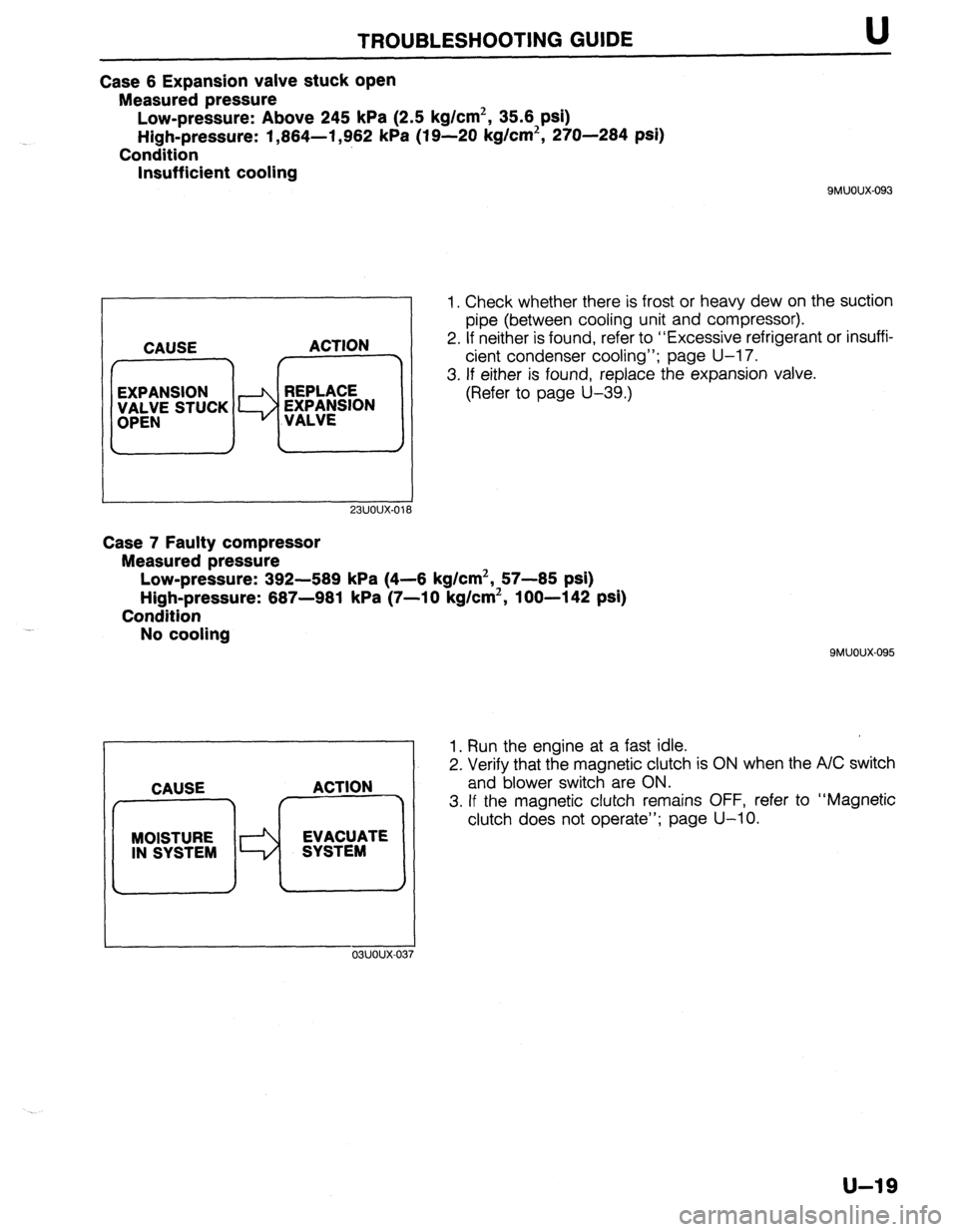
TROUBLESHOOTING GUIDE U
Case 6 Expansion valve stuck open
Measured pressure
Low-pressure: Above 245 kPa (2.5 kg/cm2, 35.6 psi)
High-pressure: 1,864-l ,962 kPa (19-20 kg/cm2, 270-284 psi)
Condition
Insufficient cooling
QMUOUX-093
23UOUX-01’
1. Check whether there is frost or heavy dew on the suction
pipe (between cooling unit and compressor).
2. If neither is found, refer to “Excessive refrigerant or insuffi-
cient condenser cooling”; page U-17.
3. If either is found, replace the expansion valve.
(Refer to page U-39.)
Case 7 Faulty compressor
Measured pressure
Low-pressure: 392-589 kPa (4-6 kg/cm2, 57-85 psi)
High-pressure: 687-981 kPa (7-10 kg/cm2, loo-142 psi)
Condition
No cooling
MOISTURE EVACUATE
IN SYSTEM SYSTEM
I
9MUOUX-095
1. Run the engine at a fast idle.
2. Verify that the magnetic clutch is ON when the A/C switch
and blower switch are ON.
3. If the magnetic clutch remains OFF, refer to “Magnetic
clutch does not operate”; page U-10.
u-19
Page 977 of 1164
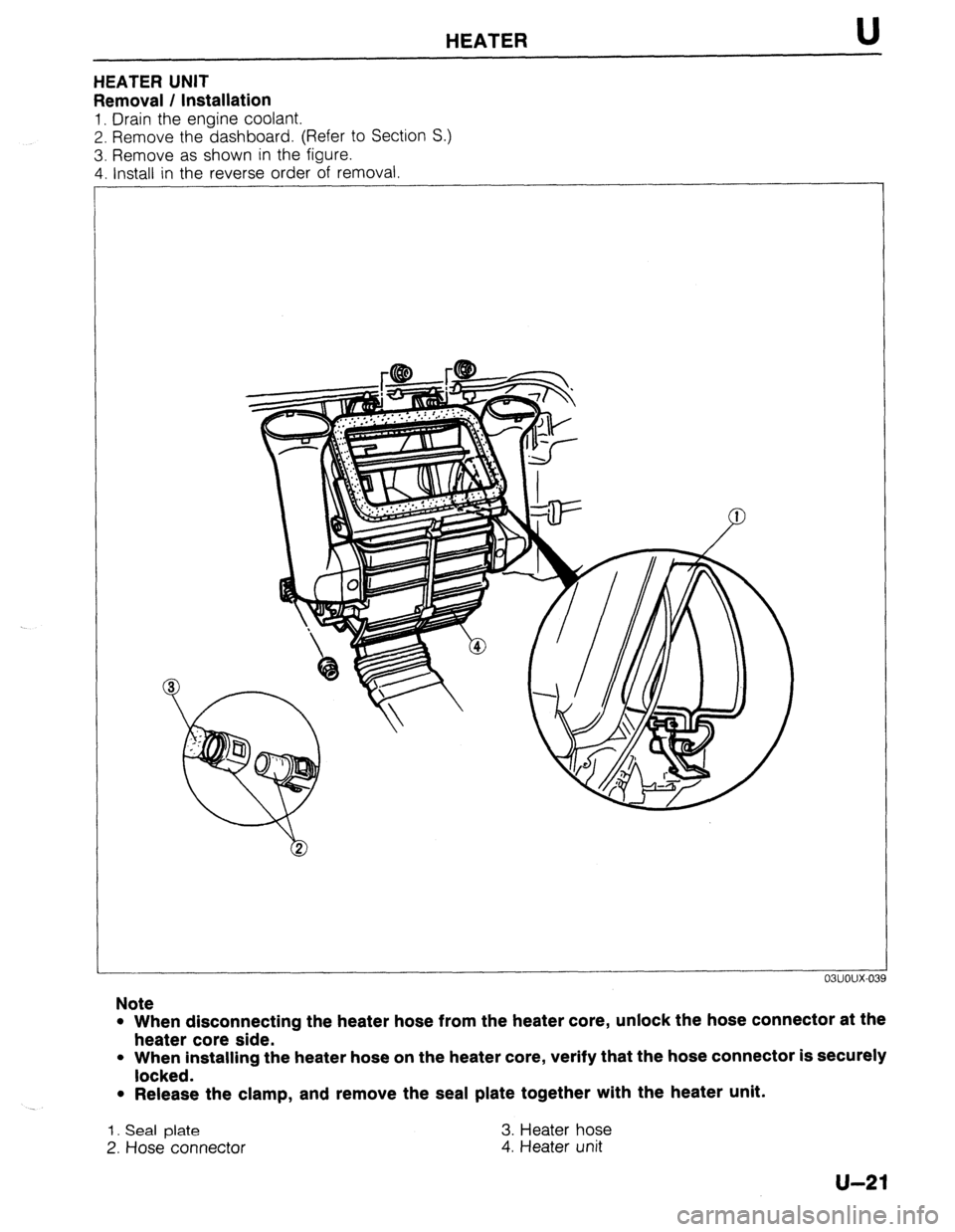
HEATER U
HEATER UNIT
Removal / Installation
1. Drain the engine coolant.
2. Remove the dashboard. (Refer to Section S.)
3. Remove as shown in the figure.
4. Install in the reverse order of removal
Note
l When disconnecting the heater hose from the heater core, unlock the hose connector at the
heater core side.
l When installing the heater hose on the heater core, verify that the hose connector is securely
locked.
l Release the clamp, and remove the seal plate together with the heater unit.
1. Seal plate 3. Heater hose
2. Hose connector
4. Heater unit
u-21
Page 990 of 1164
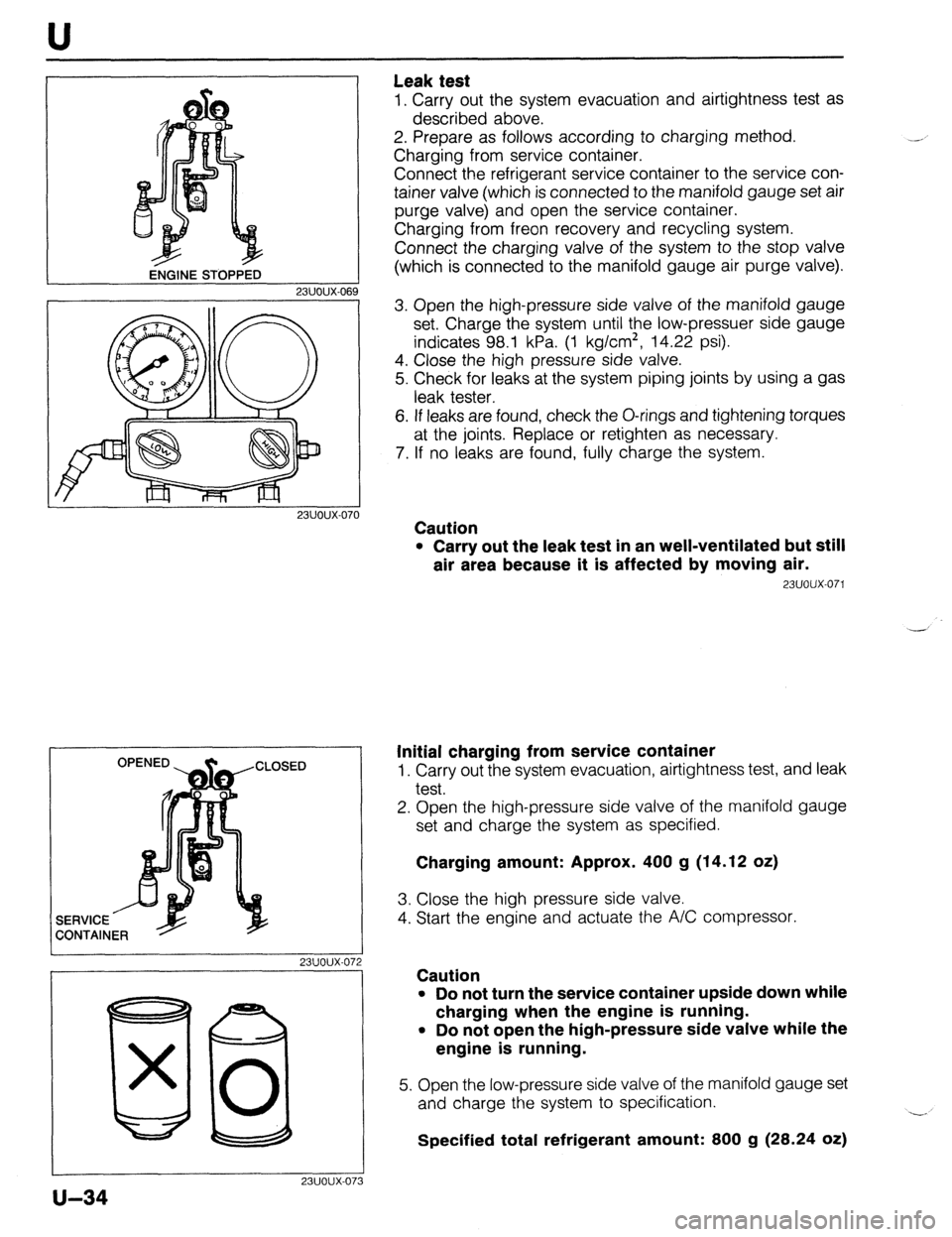
ENGINE sro~i32 U
Leak test
1. Carry out the system evacuation and airtightness test as
described above.
2. Prepare as follows according to charging method.
Charging from service container.
Connect the refrigerant service container to the service con-
tainer valve (which is connected to the manifold gauge set air
purge valve) and open the service container.
Charging from freon recovery and recycling system.
Connect the charging valve of the system to the stop valve
(which is connected to the manifold gauge air purge valve).
23UOUX-06
23UOUX-070
I 23UOUX-072
I
80 x 0
23UOUX-07
u-34
3
3. Open the high-pressure side valve of the manifold gauge
set. Charge the system until the low-pressuer side gauge
indicates 98.1 kPa. (1 kg/cm*, 14.22 psi).
4. Close the high pressure side valve.
5. Check for leaks at the system piping joints by using a gas
leak tester.
6. If leaks are found, check the O-rings and tightening torques
at the joints. Replace or retighten as necessary.
7. If no leaks are found, fully charge the system.
Caution
l Carry out the leak test in an well-ventilated but still
air area because it is affected by moving air.
23UOUX-071
Initial charging from service container
1. Carry out the system evacuation, airtightness test, and leak
test.
2. Open the high-pressure side valve of the manifold gauge
set and charge the system as specified.
Charging amount: Approx. 400 g (14.12 oz)
3. Close the high pressure side valve.
4. Start the engine and actuate the A/C compressor.
Caution
l Do not turn the service container upside down while
charging when the engine is running.
l Do not open the high-pressure side valve while the
engine is running.
5. Open the low-pressure side valve of the manifold gauge set
and charge the system to specification.
Specified total refrigerant amount: 800 g (28.24 oz) -.
Page 991 of 1164

U
L
ENGINE STARTED
*-ENGINE STARTED
23UOUX.071
6. Close the low-pressure side valve.
7. Stop the engine.
8. Close the stop valves and the service container valve.
Caution
l Do not disconnect the stop valves or the service
container valve from the charging hoses when there
is refrigerant remaining in the hoses.
Refilling
Caution
l Do not overcharge the system.
l Note the sight glass during refilling the refrigerant.
Stop charging when no bubbles are observed in the
glass.
(Refer to page U-40).
l Care must be taken when the ambient temperature
is low. The bubbles may not be present even if the
refrigerant amount is insufficient.
1. Connect the manifold gauge set to the refrigerant system
charging valve.
(Refer to page U-32).
2. Start the engine.
3. Open the low-pressure side valve of the manifold gauge set
and charge the system as necessary.
4. Note the sight glass, and when no bubbles can be seen,
close the low-pressure side valve.
5. Stop the engine.
6. Close the stop valve and service container valve. Discon-
nect the stop valves quickly.
u-35
Page 992 of 1164

U AIR CONDITIONER
DRY AND WET THERMOMETER
13uoux-014
Performance test
After finishing repairs, conduct a performance test of the air
conditioning system as follows.
1. Connect the manifold gauge set. (Refer to page U-32.)
2. Start the engine and keep the engine speed at
1,500 rpm.
3. Operate the air conditioner at maximum cooling.
4. Open all windows and doors.
5. Place a dry-bulb thermometer in the center ventilator outlet.
6. Place a dry and wet thermometer close to the blower inlet.
7. Wait until the air conditioner outlet temperature stabilizes.
Stabilized condition
Blower inlet temperature: 25-35*C (77-95*F)
High-pressure side:
1,177-1,619 kPa (12.0-16.6 kg/cm’, 171-235 psi)
Note
l If the high-pressure side becomes too high, pour
cool water on the condenser. If It is too low, cover
the front of the condenser.
8. After the air conditioner stabilizes, read the dry and wet ther-
mometer at the air inlet.
9. Calculate the relative humidity from the chart below by com-
paring the wet- and dry-bulb readings.
05uoux-051
‘C ‘F
26
24
22
20
18
16
14
12
10
U
--k----
RELATIVE HUMIDITY ‘%’
I 96U16X.103
IO. Read the dry thermometer at the air outlet, and calculate
the difference between the inlet dry-bulb and outlet dry-bulb
temperatures.
11. Verify that the intersection of the relative humidity and tem-
perature difference is in the shaded zone.
U-36